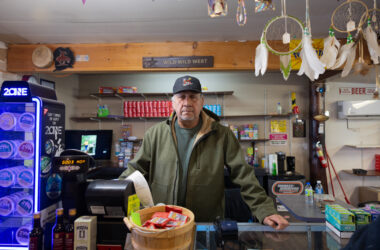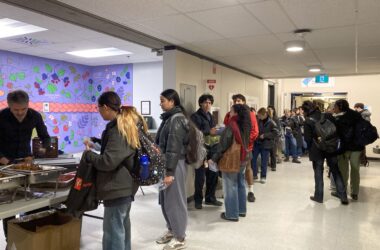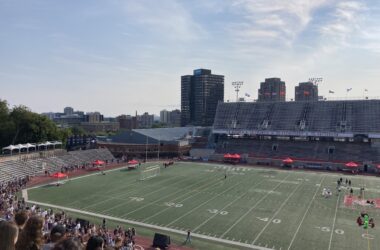 Sam Reynolds
Sam ReynoldsWhat started as a small protest in Vancouver and gained momentum on Wall Street became a global force on Saturday, Oct. 15, with occupations taking place in hundreds of cities globally. Montreal’s Square Victoria, in the downtown financial district, became the meeting point for almost a thousand ralliers and 30 to 40 tents over the weekend.
While the spirit of the movement was there, the message was less clear than that expressed on Wall Street. Most signs and supporters expressed dissatisfaction with the financial system and the lack of regulations which led to the financial meltdown in 2009. A few members of MUNACA were in attendance carrying banners, while others were waving Syrian flags. Others raised the issues of higher welfare for unemployed youth, native land claims, and environmental activism.
Angelo Cinquino, a participant who carried a sign saying “Debt is the root of all evil,” acknowledged all the mixed messages of the occupation. “Everyone’s got their own —I’m not going to say agenda—but their own reason for being here, which is [what] I think they intended it to be, but I don’t think the people are getting to the root of the problem, which I was hoping they would,” Cinquino said.
The root of the problem and his reason for attending the protest is Canadian debt, which he believes could be eradicated through a better financial system.
Others at the rally were not concerned by media reports of a the lack of a coherent, unified message.
“It’s always great to see people doing something about things that make them angry. The critique of this movement … is that there’s no clear project, and I guess I understand that critique, [but] first you have to get together and figure out what you want to do,” Bob White, a professor of anthropology at the University of Montreal, who carried his young daughter on his shoulders, said.
“But it’s hard, one of the problems in the movement is there’s an ethic of consensus, and there’s an ethic of egalitarianism and those things are great. But sometimes they limit the movement,” he added.
Underneath tarps that kept the rain off, free food was handed out by several kitchen collectives, all of whom intended to return with more food for the duration of the occupation. At times, the rally seemed as much like a festival as a political movement, with music blaring and spontaneous bouts of drumming. A medical table was set up mid-afternoon.
“I found out on the internet that every occupy site has a medic site, and I’m a nursing student so I decided to come here. My plan is to come back, all the time I can,” a nursing student who chose to be identified only as Natalie, said.
At 3 p.m., demonstrators moved to the north side of Square Victoria for a general assembly. Since there is no official organization, hierarchy, or leadership within the movement, decision-making was entirely consensus-based.
A few police cruisers blocked off traffic, part of the minimal police presence at the rally. Under Montreal’s bylaws Square Victoria is technically a square and not a park, but overnight camping is still illegal. Police are observing the occupation and no arrests were made Saturday night.
Although most of the ralliers disbanded at the end of Saturday, those who remained intend to stay.
One protestor, a student at Cégep du Vieux Montreal, said he planned to stay “until I get way too cold or beaten up by the cops.”
He went on to explain his reasons for occupying Square Victoria. “Personally, I want the end of capitalism, and I want self-determination, and that’s what’s happening right now, people are gathering and making decisions by themselves. It’s anarchy in the sense that’s defined in the dictionary, not in the sense that the media uses it.”






